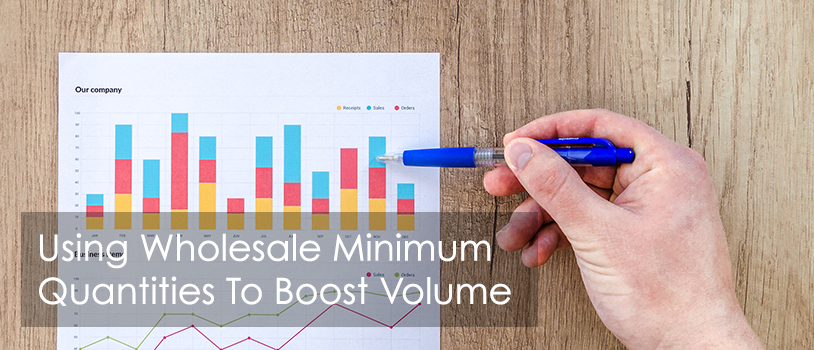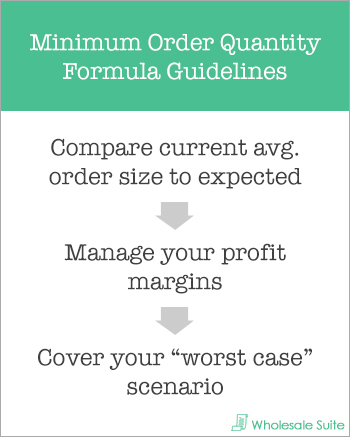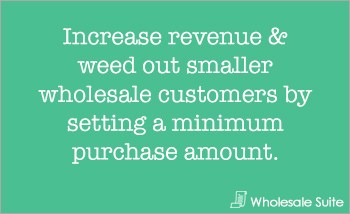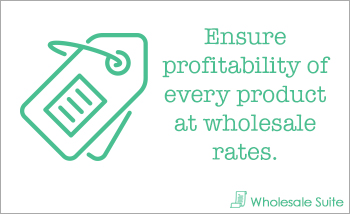
The good thing about a wholesale business compared to retail is that you are in control of the minimum amount that people should order from you in one go.
This means you are able to set a wholesale minimum order quantity for their purchase so that they must reach that level of commitment in order to achieve wholesale pricing.
It’s a fantastic way to boost the volume of items in an order. This article will take you through the ins and outs of setting minimum terms for your wholesale orders.
Wholesale Minimum Order Quantity
There are a few reasons why you might want to set a wholesale minimum order quantity:
- It lets you define what the minimum profitability should be in a wholesale order
- Customers will know what is expected of them
- A quantity minimum means you can always expect orders of a certain size or bigger
- Setting a minimum quantity means you could apply other benefits such as free shipping because the margins are built in
Minimum Order Quantity Formula
 Setting a minimum order quantity for wholesale is a great way to ensure that your customers are meeting your expectations. But how do you arrive at this value? Is there an easy formula to use?
Setting a minimum order quantity for wholesale is a great way to ensure that your customers are meeting your expectations. But how do you arrive at this value? Is there an easy formula to use?
While there isn’t a strict formula there is a number of things you might be able to follow as a guide:
- Your average order size vs. what you want your average order size to be
- The average profit per item
- A worst case scenario
If you’re just starting out then it could be difficult to know what the average order size is without some history of orders to go by.
If you have it though, it’s a great way to figure out where you are currently compared to where you want to be.
Setting your minimums just above the average order quantity is a way to suggest to those that fall below the minimum to increase their order quantities. This will boost your volume significantly without putting undue pressure on your best customers.
The average cost and revenue per item let you determine how much profit you are making per item (on average) and can be used to work backward to average quantities from the target revenue you want to be seeing per order.
Finally, a worst-case scenario is when someone orders 100% of their order as the cheapest item in the store just to get their order quantity up.
This is something you should expect customers to do if you set quantity based minimums.
What you need to know is if it would be enough to turn a good enough profit (after shipping, taxes, etc) for that order to be worthwhile. Remember, this is your worst-case scenario, it’s not likely what your customers will do, but you do want to ensure you turn a profit even in this case.
So hopefully that highlights some of the benefits of a quantity based minimum, but did you know there are several other minimums that you can apply to wholesale orders as well?
Let’s explore two other ways you can enforce minimums on your customers.
Wholesale Minimum Purchase Amount
 Slightly different to the wholesale minimum order quantity is the wholesale minimum purchase amount.
Slightly different to the wholesale minimum order quantity is the wholesale minimum purchase amount.
The main difference here is that the minimum is enforced on the subtotal of your wholesale customer’s order.
This then implies that they need to maintain a minimum spend in order to keep being a wholesale customer of yours.
Implementing a wholesale minimum purchase amount is a great way to weed out the smaller businesses and focus only on those who can maintain a certain minimum value in their regular orders.
It can also help with forecasting revenue because you know that wholesale orders are guaranteed to meet the minimum subtotal.
Wholesale Minimum Per Product
 Another alternative would be to place a minimum amount on the products themselves.
Another alternative would be to place a minimum amount on the products themselves.
A product minimum ensures that you only sell that product at wholesale rates if the wholesale customer has that quantity or more in their cart of that particular product.
It is generally irrespective of whatever minimums you have placed on the order as a whole.
I personally think this is a fantastic alternative because it means you don’t necessarily have to put strict minimums on the order as a whole, only the products themselves to ensure that you sell them in enough quantity to ensure a good profit after applying wholesale discounts, taxes, and shipping. The profit margins are then calculated and ensured by looking at the individual products, not the order as a whole. See this post for more information on pricing products appropriately for wholesale.
Using per product wholesale minimums also doesn’t mean that you can’t have your wholesale minimum order quantity and wholesale minimum purchase amounts set as well. You could apply those on top of your per product minimums.
What Is Right For Your Business?
If you’re looking for a solution to do all of the above then the WooCommerce Wholesale Prices Premium add-on is what you need, it handles every scenario here and more.
The main thing you need to remember about setting minimums for quantities, purchase amounts and products is that it affects the way your customers interact and order from you.
While it is great to talk about what it means for your business, the true litmus test is to put yourself in the shoes of your wholesale customer and see the restriction from their side. Is it a fair restriction and will they be happy to agree to meet it? Does it change the way they might order from you in any way?
An honest evaluation from your customers is the best way to ensure your success when setting minimum requirements of your wholesale program.




